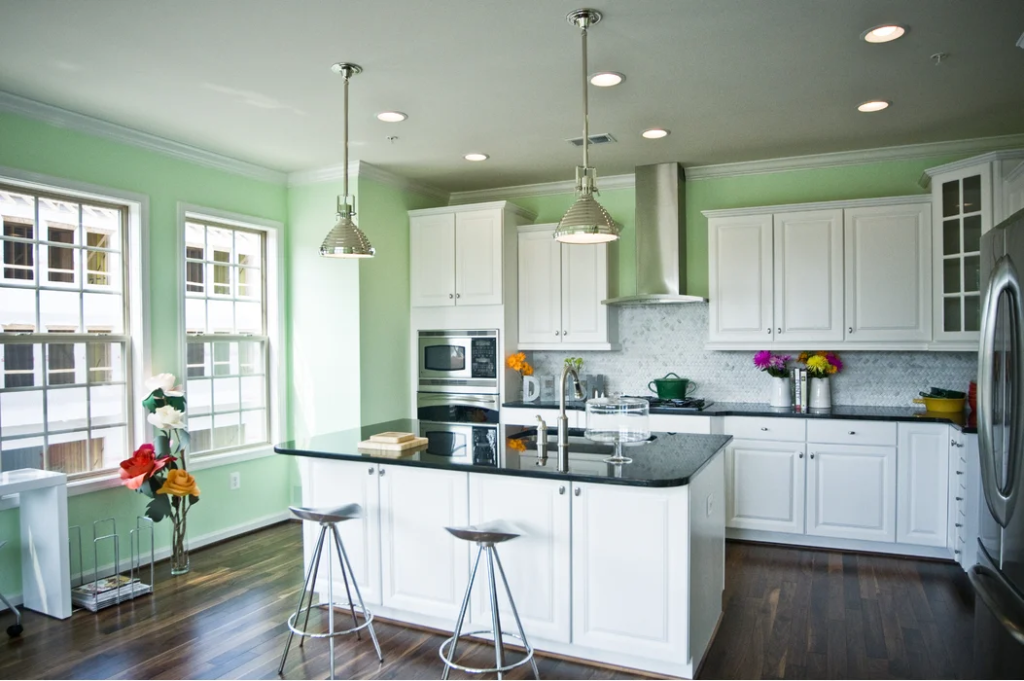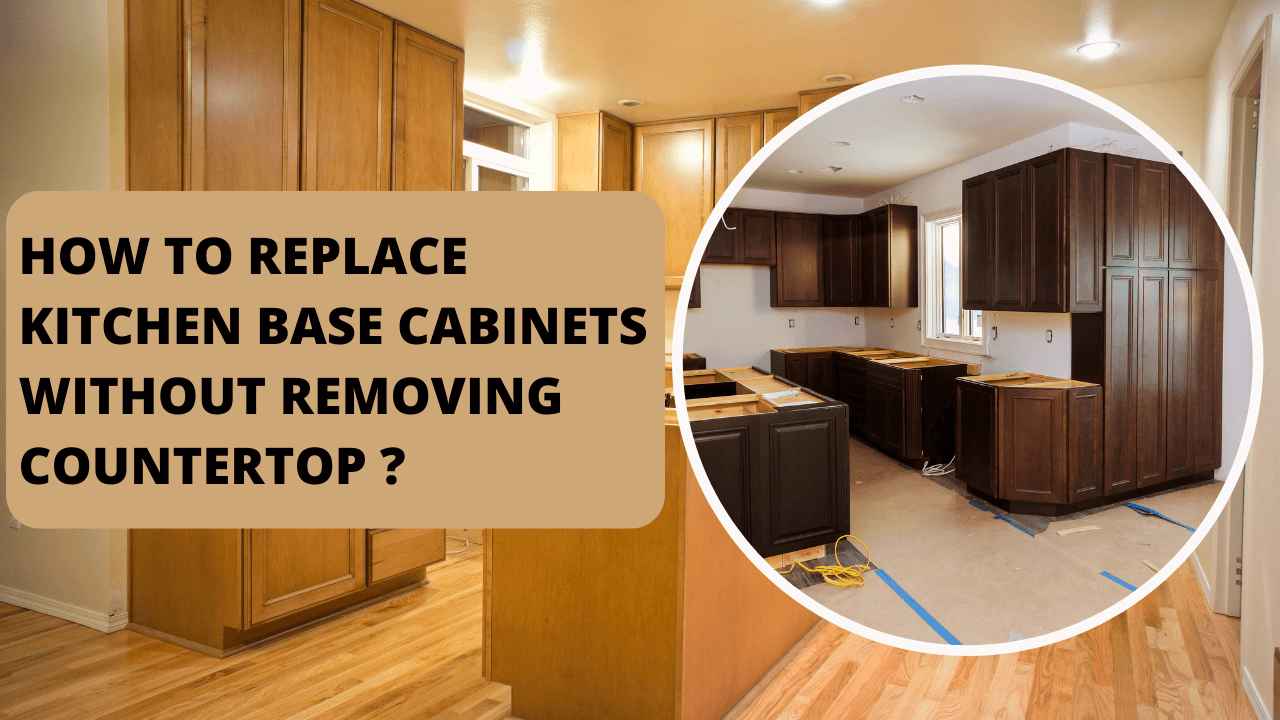Assessing the Situation: Replacing Cabinets Without Removing Countertop

Replacing kitchen cabinets without removing the countertop is a project that can save time and money, especially if the countertop is in good condition. It’s a common approach when homeowners want to update the look of their kitchen without undertaking a full-scale renovation.
However, this approach isn’t always feasible, and there are certain challenges that you need to consider before embarking on this project.
Factors to Consider, Replacing cabinets without removing countertop
Before you decide to replace cabinets without removing the countertop, there are a few key factors to consider:
- Countertop Height: The height of your existing countertop will determine the height of the new cabinets. If you want to change the height of your cabinets, you’ll need to remove the countertop and install a new one.
- Cabinet Depth: The depth of the new cabinets should match or be slightly shallower than the existing countertop overhang. If the new cabinets are deeper, you’ll need to remove the countertop to adjust the overhang.
- Cabinet Style: The style of the new cabinets should complement the existing countertop. If the countertop is modern, you’ll want to choose cabinets with a similar aesthetic.
- Installation Challenges: Replacing cabinets without removing the countertop can be challenging, especially if the cabinets are large or heavy. You’ll need to be able to maneuver the new cabinets into place without damaging the countertop.
Challenges of Replacing Cabinets Without Removing Countertop
There are several challenges associated with this project:
- Limited Space: Working with a countertop in place can limit the amount of space you have to maneuver the new cabinets. This can make installation more difficult and time-consuming.
- Potential Damage: If you’re not careful, you could damage the countertop while installing the new cabinets. It’s important to take your time and use caution to avoid any accidents.
- Limited Customization: You may have fewer options for customization if you’re working with an existing countertop. For example, you may not be able to choose cabinets with a different depth or height if the countertop doesn’t allow for it.
- Professional Assistance: If you’re not comfortable with DIY projects or if the installation seems too complex, it’s a good idea to hire a professional. They can help you assess the feasibility of the project and ensure that the new cabinets are installed properly.
Determining Feasibility
Here are some tips for determining if replacing cabinets without removing the countertop is feasible for your kitchen:
- Measure Carefully: Measure the existing cabinets, countertop, and the space available for the new cabinets. This will help you determine if the new cabinets will fit and if there will be enough room to maneuver them into place.
- Consider the Weight: The weight of the new cabinets is another important factor. If they are heavy, you’ll need to make sure that the countertop can support the weight and that you have the necessary equipment and assistance to install them.
- Assess the Existing Countertop: Make sure the existing countertop is in good condition and that it won’t be damaged during the installation process. If the countertop is old or damaged, it may be a better idea to remove it and install a new one.
Preparation and Planning

Replacing cabinets without removing the countertop requires careful planning and preparation to ensure a smooth and successful project. This section will Artikel the essential measurements, tools, materials, and a step-by-step plan for this renovation project.
Cabinet Measurements and Calculations
Accurate measurements are crucial for choosing the right replacement cabinets. This step involves determining the dimensions of the existing cabinets and the available space for the new ones.
- Measure the width, depth, and height of each existing cabinet, including any overhangs or moldings.
- Note the location of any plumbing, electrical, or gas lines that may interfere with the installation.
- Consider the desired layout and configuration of the new cabinets.
- Factor in the thickness of the countertop and any backsplash when calculating the height of the new cabinets.
- Consult with a professional if you have any doubts about the measurements or calculations.
Tools and Materials
A comprehensive list of tools and materials will ensure you have everything you need for the project. This list may vary depending on the specific cabinets and the scope of the renovation.
- Safety gear: Safety glasses, gloves, and a dust mask.
- Hand tools: Hammer, screwdriver, tape measure, level, pencil, and utility knife.
- Power tools: Drill, jigsaw, circular saw, and sander.
- Cabinet installation hardware: Screws, brackets, and hinges.
- New cabinets: Choose cabinets that match your style and budget.
- Cabinet installation materials: Silicone sealant, wood filler, and paint or stain.
- Optional tools: A stud finder, a laser level, and a helper to assist with lifting and installing the cabinets.
Step-by-Step Plan
A well-defined plan will guide you through the entire process of removing the old cabinets and installing the new ones. This plan should be flexible and adaptable to unforeseen circumstances.
- Prepare the work area: Clear the area around the cabinets and cover the floor with drop cloths.
- Remove the old cabinets: Disconnect any plumbing or electrical lines connected to the cabinets. Carefully remove the doors, drawers, and shelves. Unscrew the cabinets from the walls, being careful not to damage the countertop or surrounding walls.
- Prepare the walls: Repair any damage to the walls or backsplash. Clean the walls thoroughly to remove dust and debris.
- Install the new cabinets: Attach the base cabinets to the walls using brackets and screws. Make sure the cabinets are level and plumb.
- Install the upper cabinets: Install the upper cabinets above the base cabinets, ensuring they are aligned and level.
- Attach doors and drawers: Install the doors and drawers on the new cabinets, making sure they operate smoothly.
- Finish the installation: Caulk any gaps between the cabinets and the countertop or walls. Apply wood filler to any gaps or holes.
- Clean up: Dispose of any debris and clean the work area thoroughly.
Installation Techniques

Installing new cabinets without removing the countertop requires careful planning and execution. This section explores various methods and techniques to ensure a smooth and successful installation.
Methods for Installing Cabinets
There are several methods for installing new cabinets without removing the countertop, each with its own advantages and disadvantages.
- Installing cabinets directly onto the countertop: This method involves attaching the cabinets directly to the countertop using screws or brackets. It is the most straightforward approach, but it can be challenging to ensure proper alignment and stability.
- Using shims and spacers: Shims and spacers are essential tools for achieving proper alignment and leveling. Shims are thin pieces of wood or plastic used to fill gaps and create a level surface. Spacers are used to maintain consistent spacing between cabinets and the countertop.
- Using a countertop support system: Some manufacturers offer countertop support systems that provide a stable platform for cabinets to rest on. These systems typically consist of brackets or beams that are attached to the countertop and the wall.
Using Shims and Spacers
Shims and spacers are essential tools for ensuring proper alignment and leveling of cabinets. They are particularly useful when working with uneven surfaces or when the countertop is not perfectly level.
- Shims: Shims are thin pieces of wood or plastic that are used to fill gaps and create a level surface. They can be adjusted to fine-tune the position of cabinets and ensure they are flush with the countertop.
- Spacers: Spacers are used to maintain consistent spacing between cabinets and the countertop. They are typically made of plastic or metal and come in various sizes. Spacers help ensure that cabinets are evenly spaced and that there is enough room for doors and drawers to open and close properly.
Attaching Cabinets to the Countertop
Attaching cabinets to the countertop is a crucial step in the installation process. It ensures that the cabinets are securely fixed in place and that they can withstand the weight of items stored inside.
- Screws: Screws are commonly used to attach cabinets to the countertop. The screws should be long enough to penetrate both the cabinet and the countertop, but not so long that they protrude through the bottom of the countertop.
- Brackets: Brackets can also be used to attach cabinets to the countertop. Brackets provide a more secure attachment than screws alone. They are typically made of metal and come in various sizes and shapes.
- Countersinking: When using screws, it is important to countersink the screws to prevent them from scratching the countertop. Countersinking involves drilling a pilot hole slightly smaller than the screw diameter and then using a countersinking bit to create a recess for the screw head.
Visual Guide for Attaching Cabinets to the Countertop
Step 1: Align the cabinets with the countertop and ensure they are level.
Step 2: Use shims and spacers to create a level surface and maintain consistent spacing.
Step 3: Mark the locations for screw holes or bracket attachments on the countertop.
Step 4: Drill pilot holes for screws or install brackets according to manufacturer’s instructions.
Step 5: Attach the cabinets to the countertop using screws or brackets.
Step 6: Tighten the screws or brackets securely to ensure a strong and stable connection.
Note: It is important to use the correct type and size of screws or brackets for the specific countertop material and cabinet construction. Always consult the manufacturer’s instructions for specific installation recommendations.
Replacing cabinets without removing countertop – Replacing cabinets without removing the countertop is a great way to refresh your kitchen or bathroom without a major overhaul. If you’re looking for a way to maximize storage space, consider countertop cabinets with drawers , which can be easily installed without disturbing your existing countertop.
These cabinets offer a sleek and modern look while providing ample storage for all your essentials.
Replacing cabinets without removing the countertop can be a smart way to refresh your kitchen without a major overhaul. You might even want to consider adding some bedroom wall reading lights to create a cozy reading nook in your kitchen.
This approach allows you to customize your cabinets to fit your needs and style while keeping your budget in check.
